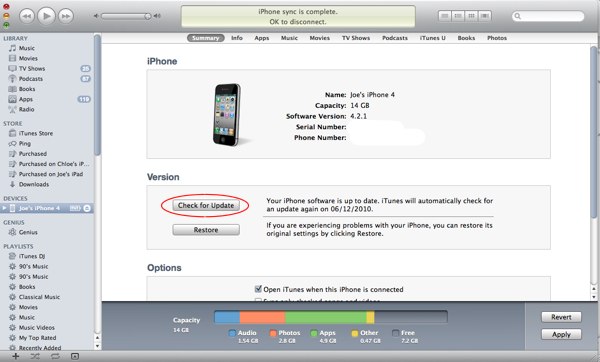
iOS 101: iTunes - How To Configure Sync, And Update Your Device
by Joe White
December 1, 2010
If you’re new to the iPhone, iPad, or iPod touch, then you’ve probably got over a hundred questions regarding your shiny, new device. Here at AppAdvice, we strive to answer them one question at a time, each and every day. This is iOS 101, and class is about to begin.
One of the most important aspects of owning an iDevice, is syncing and updating it. While it is possible to live without syncing, by downloading all your music and apps from the iTunes and App Store apps, syncing places all your tracks in iTunes. And, it also means you can install select iOS applications from the vast number you'll accumulate over time. This is especially important for those of you who have iDevices with limited storage capacity.
You see, with Sync, you can quickly and easily choose exactly what you want to transfer onto your iPhone, iPad, or iPod touch. Personally, I have over 50GB of music in my iTunes library, and around 12GB of iOS applications. It would be impossible for me to carry everything around on my 16GB iPhone 4. However, thanks to Sync, I can throw a couple of apps on my iPhone, and an album or two, in no time at all.
Updating, too, is essential. Thankfully, Apple is continually turning out new versions of its mobile operating system, iOS, for users to download, install, and use. A prime example of this is iOS 4.2 (technically iOS 4.2.1), a "unification" update which was released recently. This new version of the iOS brought a whole load of new features to the iPad, Apple's 9.7" touchscreen device. It was therefore more important than ever for iPad owners to download and install iOS 4.2. Later on in this class, we're going to look at how you can update your iDevice. But, first, let's take a look at syncing.
In order to sync your iDevice, you first need to plug it into your PC or Mac using a USB cable. If you bought your iDevice second-hand, and it didn't come with a USB cable, then you need one. Apple sells their own cable for $19.00, though you can pick one up on Amazon for under $2.00. You can also pick up power adapters for your iDevices, which are great, as they make charging your iDevice a much quicker (and less painful) task.
Next, you need to open up iTunes. If you own a Mac, then iTunes comes preloaded with Mac OS X. However, if you own a PC, then you'll need to head over to Apple's downloads page, and get yourself a (free) copy of iTunes. Once you've got iTunes installed, then you're ready to proceed.
You've plugged your iDevice USB cable into the USB port on your PC or Mac, and you've plugged the other end into you iPhone, iPad, or iPod touch. Now, your iDevice will sync - though as of yet, we won't have specified exactly what we want to happen when we next sync the iDevice. However, before we get to this, let's take a look at the iDevice page in iTunes.
As you can see from the screenshot below, the iDevice page in iTunes shows off a lot about your iDevice. I've circled important aspects in red, which we'll discuss now.
Starting at the top of the page, and heading down, you've got:
 Syncing
Syncing
In order to sync your iDevice, you first need to plug it into your PC or Mac using a USB cable. If you bought your iDevice second-hand, and it didn't come with a USB cable, then you need one. Apple sells their own cable for $19.00, though you can pick one up on Amazon for under $2.00. You can also pick up power adapters for your iDevices, which are great, as they make charging your iDevice a much quicker (and less painful) task.
Next, you need to open up iTunes. If you own a Mac, then iTunes comes preloaded with Mac OS X. However, if you own a PC, then you'll need to head over to Apple's downloads page, and get yourself a (free) copy of iTunes. Once you've got iTunes installed, then you're ready to proceed.
You've plugged your iDevice USB cable into the USB port on your PC or Mac, and you've plugged the other end into you iPhone, iPad, or iPod touch. Now, your iDevice will sync - though as of yet, we won't have specified exactly what we want to happen when we next sync the iDevice. However, before we get to this, let's take a look at the iDevice page in iTunes.
As you can see from the screenshot below, the iDevice page in iTunes shows off a lot about your iDevice. I've circled important aspects in red, which we'll discuss now.
Starting at the top of the page, and heading down, you've got:
- Media bar: this section of the iDevice page contains differing media types within your iTunes library. In order to sync music, you need to head to the "Music" section. In order to sync TV shows, head to the "TV Shows" section. We'll take a closer look at this in a minute or two.
- iDevice overview: this gives you a quick burst of info about your iPhone, iPad, or iPod touch. As you can see, "Name," "Capacity," and "Software Version" are all displayed, along with "Serial Number," and "Phone Number." However, clicking on "Software Version," "Serial Number," and "Phone Number" will also change what the iDevice overview displays, showing other aspects (such as "IMEI Number," for example).
- Next you've got two important buttons: "Check For Update," and "Restore." We'll discuss both of these later.
- Capacity: this is a visual representation of your iDevice's capacity.
- Sync: surprisingly, this button syncs your iDevice.







